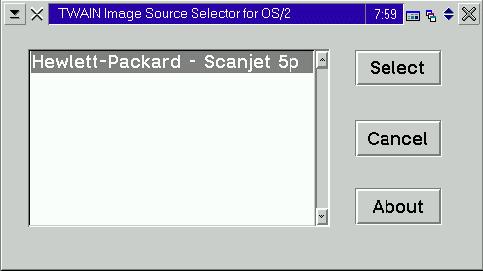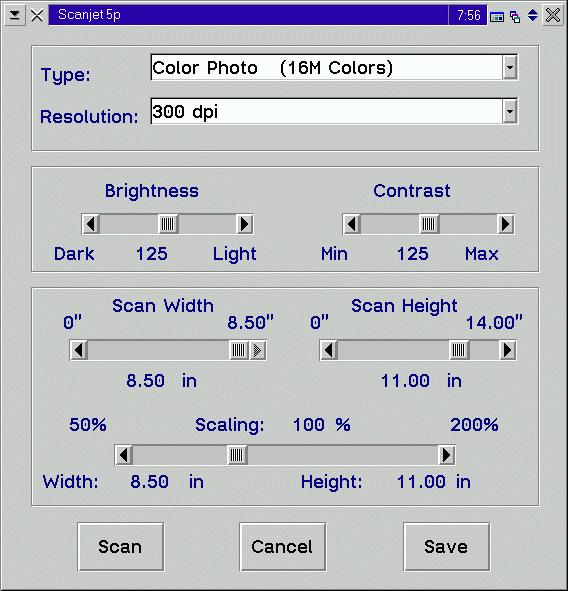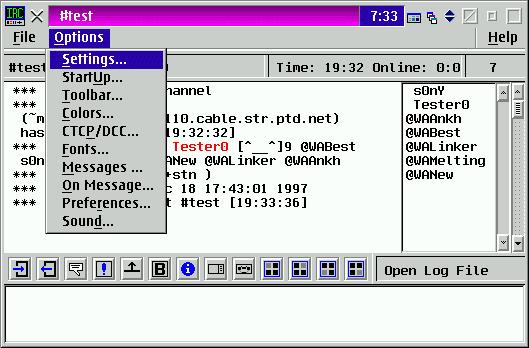

By Mark Dodel, HTTP://204.186.32.110 or http://home.ptd.net/~madodel
So what's the big deal about Twain anyway? Well it's an attempt to standardize access
to image acquisition devices in software applications - http://www.twain.org.
This includes digital cameras as well as scanners. Before twain you had to make
sure that the software package supported your make and model of scanner. I like
CopyShop/2 for scanning, copying and faxing, but it will only work with HP scanners
because that is the only driver supplied. If it were twain compliant, it should
work with any twain scanner. So long as you have an OS/2 twain driver that supports
that scanner, you can use any graphics software package that is twain enabled. Of
course that is not 100% accurate, since Embellish so far only works with the twain
driver from CFM - http://www.cfm.de/ibm_os2.htm,
but STI says they are working with Dadaware - http://www.dadaware.com/
to help get Embellish working with the STI twain driver as well.

To perform a scan, select Acquire from the File menu, you'll get the following screen.
This allows you to configure the scanning parameters. You choose the type of scan,
from Black and White, Black and White Halftone, Black and White 16 Grayscale, Black
and White 256 Grayscale, Color Drawing (256 Colors), and Color Photo (16M Colors).
You can select a resolution between 75 dpi up to 600 dpi. Brightness and Contrast
can be adjusted using slider controls. There is no preview mode, but you can adjust
the scan width and height. Keep in mind that the larger the image and the higher
the resolution the longer the scan takes, and the larger the resulting image file.
When you are done with your adjustments select the Scan button and away it goes.
You can select Save to save the settings you configured.

Reviewed or mentioned in this article:
Solution Technology Twain for OS/2 Driver Pack - $45.00, IBhttp://www.indelible-blue.com/
CFM Twain for OS/2 - $50.00, BMT http://www.bmtmicro.com/catalog/cfmtwain.html
I reviewed the OS/2 system logging utility Opconsol in the October VOICE newsletter,
and I had asked if anyone knew what happened to development of this application.
Well good news. The author of Opconsol - Gary Green was sent a copy of my review
and contacted me. He is still trying to recover from a system crash that wiped out
18 months of his development code with it. He is in the process of recreating Opconsol
from scratch. If you have any suggestions, or just want to send a word of encouragement
he can be reached at garygreen@ibm.net
He is still working on recreating version 1.3 of Opconsol, and is adding some increased
functionality including the ability to "extend OPCONSOL with your own command
library. I provide the requirements and anyone that follows the rules can add their
own commands (or even replace my commands)."
Opconsol is an OS/2 system logging utility based on the IBM mainframe MVS system
log in appearance and functionality. It is available at ftp://ftp.leo.org/pub/comp/os/os2/leo/shells/opconsol.zip
or ftp://204.186.32.110/G/pub/utilities/opconsol.zip
In our continuing series of interviews with the people who make up VOICE, we now
interview Seth McFarland (Ptackbar), VOICE Web Master:
VOICE> How long have you used OS/2?
Seth> I've used OS/2 for about 5 years...since 2.11. I ran it on a 386/25 w/
16mb RAM.
VOICE> How do you currently use OS/2?
Seth> Well, currently I use OS/2 for everything. Everything I do basically is
internet related. I create all HTML and graphics in OS/2 using EPM and Adobe Photoshop
3 (in Win-OS/2). Nothing matches the WPS and within the last year I've really come
to use the object oriented desktop to it's full extent.
VOICE> What is your background in computers?
Seth> I've got no background really :) I began using computers as a kid for games
and such and then for school work, learning everything I could about them on the
way. Now I am the webmaster for the North Carolina General Assembly. I also do internet
PC support for my division.
VOICE> A budding Bill Gates. Hopefully you'll show a bit of mercy to the compettition.
By the way what is 'Jamawkinaw Enterprises'?
Seth> Jamawkinaw Enterprises is a "company" which is bacially just
3 of my buddies who do web design and are beginning to work on PM OS/2 internet
applications. We might actually make money some day.
VOICE> How did you arrive at the Jamawkinaw name? Is it a Southern thing? Or
an Indian (Native American) thing?
Seth> Back in school, an African group came and presented a fable of sorts..the
main character was called "Jamawkinaw" and the name just stuck with me
for some reason...I came up with the spelling myself though :)
VOICE> What other OS/2-computer related activities are you involved with right
now?
Seth> I'm currently the webmaster for VOICE, Warpstock, and #os/2 on the undernet.
I've also done graphics for some OS/2 websites, namely The Ultimate OS/2 Gaming
page and Team OS/2.
VOICE> How did you get involved with VOICE?
Seth> Well, when the original VOICE web master didn't "work out", I
volunteered to do it.
VOICE> What does the 'VOICE Web Master' do?
Seth> I basically just put all information possible relating to VOICE on the
webpage in an organized and (hopefully) asthetically pleasing manor.
SPECIAL NOTICE IF YOU'RE RUNNING 4OS2:
-------------------------------------
If you're using 4OS2 as your command interpreter, you need to open
an OS/2 window, type CMD (to switch back to the standard OS/2
command interpreter) and then run the Suite install.
Please append here and let us know if that was the problem. If not,
still send us a feedback message as I described in my earlier posting.
Also
Feel free to pull QuickStart from your Startup folder if you feel it's
causing problems with other apps. By the way, I might as well let you
know now we plan to pull the QuickStart utility because we've discovered
it isn't providing sufficient improvement on "initial launch" of the
SmartSuite apps to warrent its use. I know this will please folks who
aren't particularly excited about having something added to their
Startup folder.
(Editor's note: I found that once I removed the Quick Start object from the Startup
folder an annoying system freeze I had been experiencing with Netscape/2 appears
to have gone away. Since there doesn't seem to be any benefit to this process anyway,
it seems like a good idea to remove it).
More information on this mailing list can be found at http://www.os2bbs.com/docs/lyris.html
For a bit of background, I am not a longtime GT-IRC user. I actually use mIRC under
Winos/2 but desire to do away with the last remnants of my DOS/Windows history.
I had used the free demo of GT-IRC 2.05 and 2.06, however, just enough to know that
it was a good client but one which needed a little work on the user interface end.
Using a native OS/2 client is wonderful if for no other reason than long filename
support for DCCs (and playing SOUNDs) and stability. GT-IRC 3.0 doesn't let you
down in these areas. There are even some new additions to both features, such as
the ability to hear (locally) a sound that you play in an IRC channel. Some other
new enhancements include the ability to hide the old toolbar (this requires a reloading
of the client, so is not supported in the demo which does not save user settings
between sessions -- that is why it is a demo) and the ability to add items to the
various popup menus on-the-fly or within a standard IRC-REXX script file. There
is also a nicely enhanced Server dialog which allows grouping of servers under a
network name (for convenience purposes). Another nice new feature is the ability
to strip mIRC color codes from incoming messages so they don't create garbage on
your screen. This is a great client for skilled IRC users. Unlike many other IRC
clients, however, it is also good for amateur uses, having a well-designed online
help file and status bar help text for the icons on the tool bar.

However the prerelease hype may have been misleading. A number of users, myself
included, were expecting full popup menu editing. This is not the case. The use
can add to the bottom of any popup menu easily, but predefined items cannot be deleted
(if you have no use for them) nor can they be rearranged (so you cannot add an unignore
item right next to the ignore item in the nicklist popup - if you add unignore,
it goes to the bottom of the menu while ignore is near the top). Furthermore, there
are no cascading menus as one finds both on the OS/2 desktop popup menu (and most
folder and app system menus) and in such clients as mIRC and OpenChat/2. This lack
of cascading menus means you cannot have one main menu item which acts as a descriptor
for various other items which are similar in purpose (i.e.. having a cascading menu
for various types of greetings for people in the channel nicklist). You must have
each and every type of greeting on the one nicklist popup menu.
It has also been stated by several users that 3.0 does not seem to be a very significant
change from 2.0x. For instance, there is still no auto-close of DCC windows on file
transfer completion, no customizable toolbar (only able to hide), no actual color
support, and all-in-all 3.0 has the same user interface as 2.0. If you liked GT-IRC
2.0, you'll love 3.0. However if you're used to a much more easily-scripted (such
as I am with mIRC's ridiculously-easy popup menu and alias editing) client, then
you may have to take a few weeks to get used to this. The power is there, and if
you know REXX you can enhance it even more, but the power is not as readily available
as it could be.
Still, thanks must go out to GammaTech for continuing to work on this, the original
OS/2 PM shareware IRC client. It has a nice solid application core that merely needs
some external enhancements. And you cannot beat the $24.95 price tag, available
now until the end of January, 1998. Try the free demo and see what the registered
version can do for you. Only through user support will the client continue to grow
and mature.
Product: GammaTech IRC 3.0
Information & Download: http://www.gt-online.com